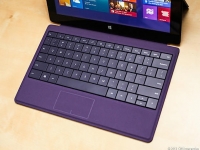
Surface Pro 2 with Type Cover keyboard.
Microsoft and Intel want you to buy 2-in-1 devices in 2014. I'm still uncertain about the category, though.
As I said last week, I've been using the Dell Venue 11 Pro, a Windows 8.1 tablet that's designed to be used with two detachable Dell keyboards.
So far, I see the promise but have some issues with the practicality.
The good news is: Dell has designed a fast, responsive Windows 8.1 tablet with a gorgeous display. Windows 8.1 is surprisingly smooth on top of Intel's Bay Trail Atom processor with only 2GB of memory.
And the Venue 11 hits a sweet spot among 2-in-1 devices. With a 10.8-inch screen, it's not so small that the size renders it impractical as a high-productivity (work) computer. And it's not too big. Any detachable with a display over 12-inches almost defeats the purpose of having a tablet.
The bad news: I'm not so sure that for the majority of consumers a detachable design has clear, irrefutable benefits over the traditional laptop design (though new designs could change that assessment in 2014).
Laptop on lap issues: Both the Surface Pro that I owned (briefly) before and the Venue 11 have compromised keyboards. The compromise is between offering a very light keyboard and offering something that's also practical.
Both fall short of touch typing on my Dell Adamo, but I eventually got used to the Surface Type Cover keyboard -- and ditto for Dell's Tablet Keyboard (the lighter, thinner model that doesn't integrate a battery).
My main beef is with consistency. When it's in laptop mode (keyboard attached), I like to use the Venue 11 (surprise) on my lap. But the Venue's keyboard sometimes flaked out, meaning the cursor would freeze or just simply disappear and never come back.
After some back and forth with Dell and some changes to the Windows Registry, things improved a bit. (Though Dell thinks it's likely a defective keyboard.) I had similar problems with the Surface Pro's keyboard when using it on my lap.
Not to mention the challenges of getting a top-heavy design (most of the weight is in the display) to remain stable while it's propped up on your legs.
The truth be told, light/thin detachable keyboards are meant to be used on a desk. That's my conclusion. I had no problems with the Surface keyboard when it was flat on the desk. Though the Dell keyboard is still not completely stable on the desk, it's much more usable.
(Here's a closer look at the Venue 11's keyboard.)
Weight paradox -- heavy, man: Let me quote Hewlett-Packard talking about its Spectre 13 x2 detachable. "When you touch a touchscreen, that's 20 pounds of force, so you need a little bit of weight in the base to balance it and have a good computing experience." (A "little bit of weight" is masterful understatement.)
Which brings us to the second kind of detachable. These eschew thin, light keyboards (with apparatus to prop up the keyboard). Rather, the keyboard is designed as a counterweight.
Enter Dell's other keyboard. The 1.75-pound (as listed in Dell's specs) Mobile Keyboard. That's a lot of weight to counterbalance the 1.6-pound tablet. And it all adds up to a pretty hefty 10.8-inch laptop. That's over three pounds for a sub-11-inch class device.

Dell Venue 11 Pro with detachable keyboard (Tablet Keyboard model without integrated battery).
And the same goes for HP's 13-inch Spectre 13 x2. With the keyboard, it's well over 4 pounds. That's well out of ultrabook territory (and in fact, HP's more traditional Spectre 13 ultrabook -- just released -- is only about 3.2 pounds.)
Which raises the question, why not just get a laptop? Isn't the whole point to have a device that's highly mobile? Or at least more mobile than a laptop; i.e., a device that's akin to an iPad Air in portability?
Windows 8.1 tablets in an Apple, Android world: In tablet-only mode, most Windows 8.1 tablets are out-classed by Apple and Android products. It's hard to pick up a 2-pound Surface Pro after using a 0.7-pound iPad Mini Retina or 0.64-pound Nexus 7.
This is improving -- Dell's Venue 8 Pro is only 0.87 pounds -- but high-profile tablets like the Surface Pro 2 are heavy and relatively big.
Here's some gratuitous advice for Microsoft: bring out a thin, light 10-inch class Windows 8.1 product. You know, like Surface 2 (RT) but one that runs the full version of Windows 8.1.
That would be a nice counterpoint to the more laptop-like Surface Pro 2.

